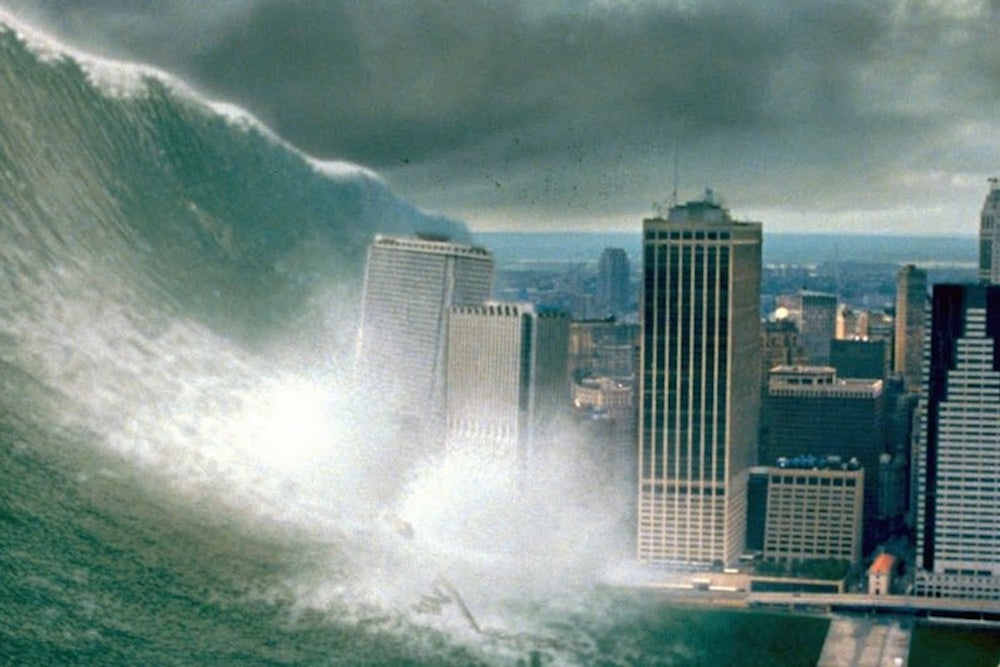On Monday, the New York Times reported on two new climate change studies that came to the same, terrifying conclusion: “The heat-trapping gases could destabilize other parts of Antarctica as well as the Greenland ice sheet, potentially causing enough sea-level rise that many of the world’s coastal cities would eventually have to be abandoned.”
Abandoned.
While actual abandonment would not happen for many years (we’re talking centuries), the studies warned that our actions now are irrevocable and will lock in these future sea level rises. In other words, our descendants will be dealing with irreversible damage that we are committing today.
So, fast forward a few centuries from now, what will the world look like? What will the United States look like? Will people still live in Miami? Boston? New York? We don’t know what technology we will have then and we aren’t able to predict the pattern of storms. We do know that sea levels are rising and will threaten cities along the coasts of the United States.
“Barring some extraordinary advances in technology that we currently do not foresee,” Robert Hartwig, the president of the Insurance Information Institute, said, “you are left with the options of retreating from coastal areas not only in the United States, but around the world, or building fortifications against rising sea levels that would make the projects that we now see in places like the Netherlands look like child’s play.”
The Dutch government has set aside one billion euros a year through 2100 to strengthen dunes and dams throughout the country. Due to its low-lying position, the Netherlands is one of the most at-risk countries and has already crafted a long-term strategy to ensure the country’s survival. But in the United States, where one of our two main political parties remains skeptical about man-made climate change, such planning is unlikely to happen.
“If you have a plan and vision to stay there it is more likely to occur,” Robert Nicholls, a professor of coastal engineering at the University of Southampton, wrote in an email. “But USA does not have a planning culture.”
Planning will not come cheap. The mitigation techniques needed to fortify a city like Miami will cost billions of dollars, if not more. State and local governments will undoubtedly turn to the federal government for help, but that will be a political nightmare. Americans from non-coastal regions will likely object to paying for the restoration and fortification of coastal cities that are no longer naturally fit for habitation.
“Ultimately, reality will set in in the United States too, despite it being a relatively wealthy country,” Hartwig said. “Some areas will necessarily be abandoned or potentially become, in effect, islands. That’s another possibility. You say to yourself, do I abandon Miami or do I simply wall in a certain number of square miles of what is currently Miami and in effect create an island?
“Resources are always scarce and there are going to be many in the United States who think spending every available dime of every available tax dollar to save people from rising sea levels on the coast is a complete waste of money,” Hartwig added. “And they will have a point, because they’re paying tax dollars in Missouri or in North Dakota and they will not directly see a return on this investment.”
Global warming poses risks besides rising sea level. Severe storms may increase in frequency, although it’s difficult to predict how they will play out. Saltwater intrusion could imperil farm land up the Mississippi River. Droughts may become more common. Already now, scientists are wondering whether we’ve reached Peak Phosphorus—the point at which we reach the maximum global production rate of phosphorus, an essential fertilizer for crops.
Colin Green, a professor of water economics at Middlesex University, wrote in an email that he tells his students three things: “(1) they will not be able to retire until they are 75; (b) they will need to become vegetarians because we don't have enough water to support a high meat based diet; and (c) that when they go to the supermarket, they will need to take their urine with them which will be analysed and then they will be able to buy food with the same phosphorus content as the urine they bought in.”
The consequences of our inaction today will not be fixable down the road, no matter how much money the government spends. Instead, we will focus on containing the damage, whether through mitigation or abandonment. Insurance will be an important tool to allow the government to spread around some of that risk. But that assumes insurers don’t deem certain areas uninsurable—and that in turn depends on what we do today.
“I would say that if you look at the gradual sea level rise predicted over the next century, provided appropriate mitigation on the structures and in the communities in the higher cities are undertaken, then insurance is possible in these areas albeit at higher costs,” Hartwig said.
In some cases, the federal government may sell the insurance. For instance, right now, the feds offer subsidized flood insurance to homeowners in at-risk areas. When Congress passed the Biggert-Waters Act in 2012 to allow those rates to rise to their market level, they faced a swift backlash from homeowners who were going to see their insurance rates skyrocket. Led by congressmen from Gulf states, Congress gutted the bill in March. If that is any sign of what is to come, then policymakers are not prepared for the infinitely higher costs and tough choices they will face down the road.
